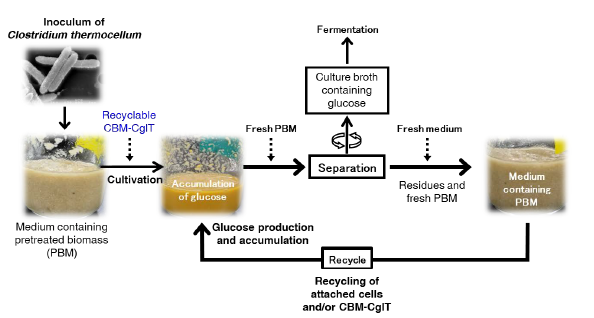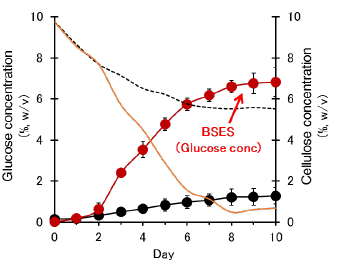Direct Saccharification Technology From Lignocellulosic Biomass
Description
Technology is important because of the high cost of obtaining fermentable sugars efficiently from cellulosic biomass. Many microorganisms capable of producing cellulose and hemicellulose-degrading enzymes have been reported and characterized. Currently, fungal cellulases are prepared and utilized to saccharify cellulosic biomass. It is known that the fungus Trichoderma reesei is able to produce high levels of secreted cellulases and several functionally distinct cellulase components. However, utilization of cellulases is an impediment to industrial application due to the high cost of enzymes.
On the other hand, Clostridium thermocellum, an anaerobic, thermophilic, spore-forming bacterium, is the most potent cellulose-degrading bacterium known to produce cellulosomes. The cellulosomes of C. thermocellum contain a surprisingly large variety of enzymes and show attractive enzymatic properties for the degradation of complex plant biomass. In a previous study, we demonstrated remarkable improvements in cellulolytic activity of cellulosomes from the hypercellulolytic C. thermocellum [1] in combination with a thermostable β-glucosidase from Thermoanaerobacter brockii (CglT) [2, 3].
In this research, we report on saccharification by C. thermocellum cultures supplemented with thermostable β-glucosidases, which we named biological simultaneous enzyme production and saccharification (BSES) [4]. BSES required no addition of cellulolytic enzymes. It can directly produce glucose from cellulosic materials due to supplementation of cellulose degrading cultures with CglT. Exclusive glucose accumulation of glucose occurred when C. thermocellum was cultured with a thermostable β-glucosidase under a high cellulose load. This approach may resolve a significant barrier to economical production of bio-based chemicals and fuels from lignocellulosic biomass.
[1] Tachaapaikoon C, et al: Biodegradation. 2012, 23:57-68.
[2] Waeonukul R, et al: Bioresour Technol. 2012, 107:352-357.
[3] Waeonukul R, et al: Bioresour Technol. 2013, 130:424-430.
[4] Prawitwong P, et al: Biotechnol Biofuels. 2013, 6:184.
Figure, table
-
Fig. 1. Schematic of consecutive biological saccharification method by recycling of the hydrolyzed residue.
Culture of C. thermocellum and supplementation of CBM3-CglT were only carried out the first biological saccharification round without further culture and addition of any enzymes [2]. To recover free cellulosomes and CBM-CglT, fresh pretreated cellulose substrates were added to the hydrolysis slurry, and then reabsorbed from the supernatant. A second round of biological saccharification was subsequently performed using the recovered enzymes by binding to fresh substrate and the hydrolysis residues containing C. thermocellum cells. Consecutive biological saccharification using these recycling procedures may be repeated several times. -
Fig. 2. Biological saccharification using C. thermocellum culture supplemented CglT. Cellulose hydrolysis ability and free sugars (glucose) accumulation was monitored under C-05 cultivation of C. thermocellum with or without CglT (+CglT/–CglT), respectively. Solid and dotted lines indicated residual cellulose contents (w/v) in culture broth. Error bars represent ± SD (n=3).
- Affiliation
-
Japan International Research Center for Agricultural Sciences Biological Resources and Post-harvest Division
- Classification
-
Research A
- Research project
- Program name
- Term of research
-
FY 2014 (FY 2011-FY 2015)
- Responsible researcher
-
Kosugi Akihiko ( Biological Resources and Post-harvest Division )
Prawitwong Panida ( Biological Resources and Post-harvest Division )
Waeonukul Rattiya ( King Mongkut's Institute of Technology Ladkrabang )
Tachaapaikoon Chakrit ( King Mongkut's Institute of Technology Ladkrabang )
ORCID ID0000-0001-9795-2558Ratanakhanokchai Khanok ( King Mongkut's Institute of Technology Ladkrabang )
- ほか
- Publication, etc.
-
https://doi.org/ 10.1186/1754-6834-6-184
Prawitwong P et al. (2013) Biotechnol Biofuels, 6:184-195.
JIRCAS Research Highlights (2011) No.13
Kosugi, et al. "Method for Producing Glucose". JP2013056511
- Japanese PDF
-
2014_C05_A3_ja.pdf413.79 KB
2014_C05_A4_ja.pdf369.17 KB
- English PDF
-
2014_C05_A3_en.pdf109.82 KB
2014_C05_A4_en.pdf132.4 KB
- Poster PDF
-
2014_C05_poster.pdf362.34 KB


